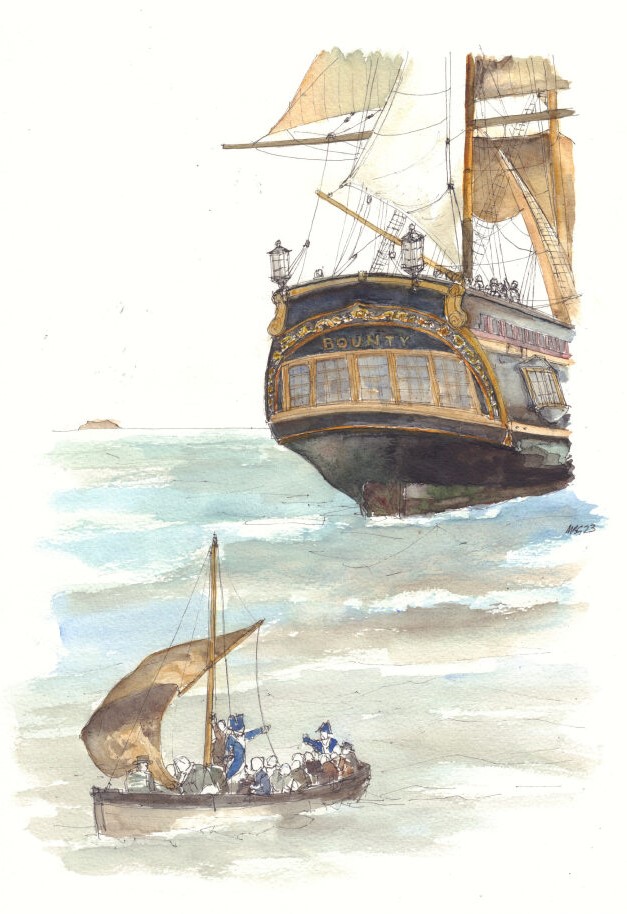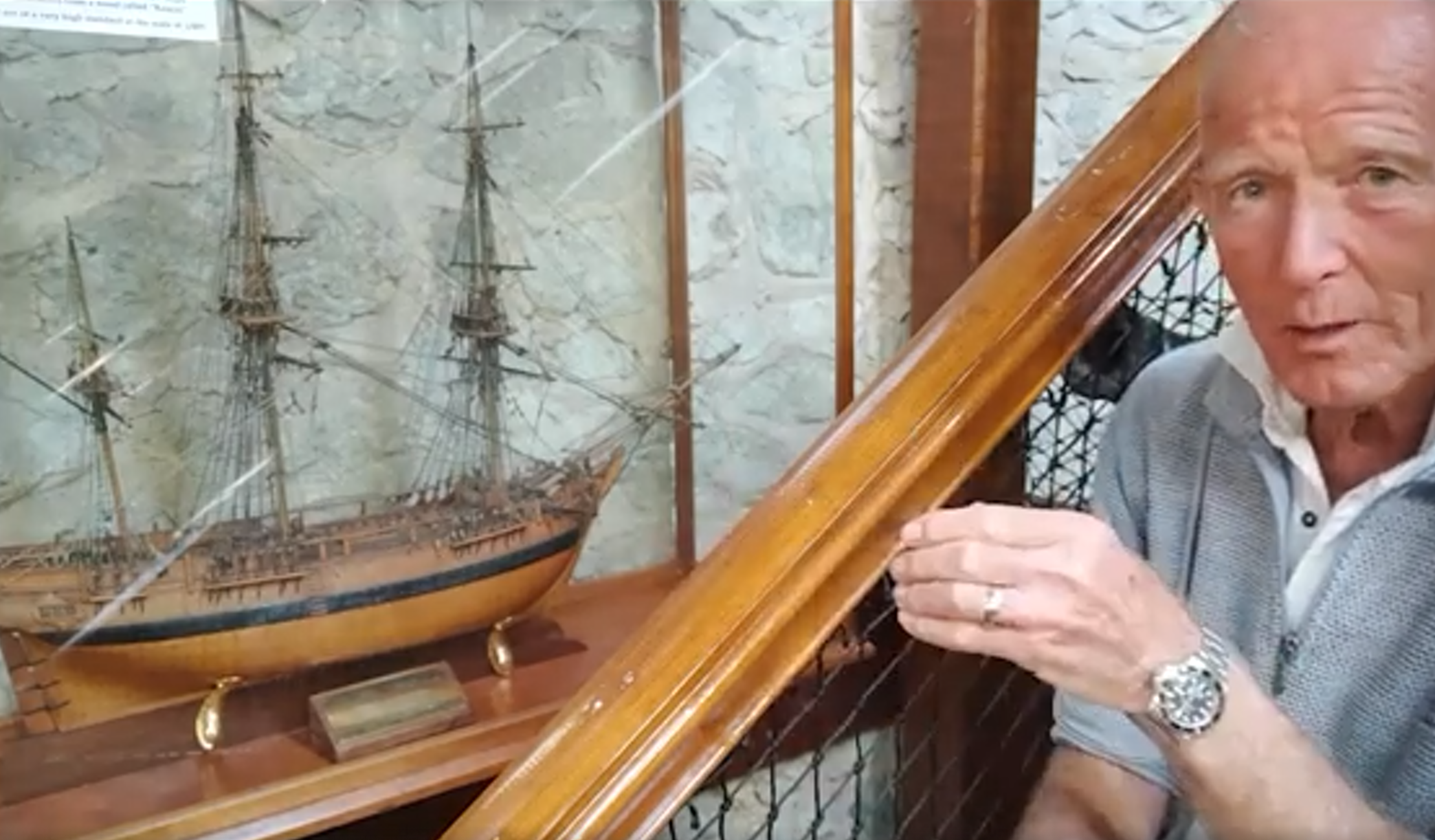Immortalised into movie history in 1962 with Marlon Brando and again in 1984 with Anthony Hopkins, the story of the mutiny on the Bounty has long been a fascinating part of maritime history at the peak of British colonial rule. With the anniversary of the launch of the HMS Bounty fast approaching on the 3rd of September, volunteer Katie McAvelia dives into the story of the famous mutiny, taking us all the way from the Solent to the South Pacific.
The Bounty mission was a botanical one, searching for breadfruit (closely related to the fig), in order to sustain slaves on the sugar plantations of the West Indies. Its story is indelibly tied to slavery and the sugar rush that dominated commerce and fortunes of the period, and it was commanded at the time of its chaotic and dramatic journey by William Bligh. Considered by some to be the archetypal tyrannical ships captain, all be it with an impressive record. Bligh was recommended for the position of commander having been Captain Cook’s own sailing master on the Resolution during its 3rd voyage which crossed the Arctic circle.
Setting sail in 1787, the Bounty, left Spithead in the Solent and spent ten months and 27,000 miles at sea, navigating the equator, Cape Horn and after changing course, the Cape of Good Hope before finally arriving in Tahiti or ‘Othaeite’ as it was known in 1788. The Bounty spent a total of 5 months carrying out its mission, collecting over one thousand breadfruit plants for transportation. Time spent on the island also found the crew collecting native customs, tattoos, and in the case of master’s mate Fletcher Christian, who we’ll meet again, even a Tahitian wife, Mauatua.
Departing Tahiti in 1789 with its cargo of breadfruit, Commander Bligh was shortly to face mutiny from twenty-two of his men. Bligh reportedly sowed the seeds of mutiny through his disciplinary attitude. Christian bore the humiliation of Bligh for the final time on the 27th April 1789, having been accused of stealing from the ships food stores. This was the provocation that finally sparked the match for the trouble to come. By the next day on the 28th April, the mutiny was in full swing, splitting the ship into two factions. Taken bloodlessly, it wasn’t long until the Bounty fell under control of the Christian and his rebels.

Figure 1: HMS Bounty mutiny, painted by Mike Greaves
Overcome and resigned the ship’s boat, Bligh, with several crew that remained loyal, undertook a perilous journey to Coupang, a Dutch colony in Timor over 3,500 nautical miles away. To some he was a questionable commander but undeniably, a talented seaman, having navigated the journey without a map. Bligh and his small crew arrived forty-seven days later where they raised the alarm about the mutiny on board the Bounty. Bligh would later return to England where he was acquitted of any wrongdoing.
Meanwhile the mutineers, initially sailed for the Tubuai where they were greeted with hostile fighting from the native islanders. After three months they were forced to return to Tahiti. Arriving back, sixteen of the mutineers chose to remain there, taking their chances that they would not be captured, although this would be short lived. The HMS Pandora sent by the Admiralty arrived to capture and return the mutineers for trial, detaining them onboard the ship in the aptly names ‘Pandora’s box’. The mutineers remained imprisoned on the ship until it was wrecked on the Great Barrier Reef during its return journey in 1791.
Christian, not wanting to remain on Tahiti, set sail again with his remaining crew as well as Tahitian captives which he had lured on board unwilling, later proving to be his own downfall. Upon leaving, Christian and his crew found the Bounty grounded on a sunken reef. Wanting to make a quick exit, they used the ship’s spare anchor to haul her off but the anchor ultimately became stuck in coral so they had to cut it loose and leave it behind. The anchor was retrieved in 1935 and is still currently able to be viewed in a public square on Pitcairn island. Having freed the ship, Christian sailed on, passing Fiji and the Cook Islands before arriving at the Pitcairn islands in 1790. These islands having previously been lost on Naval maps, looked to be a promising hide out for the remaining mutineers and their Tahitian captives. Once reaching the island, the crew removed all supplies from the ship and set fire to the Bounty in what is now known a ‘Bounty Bay’, to prevent any chance of discovery or escape. The burning of the Bounty is now celebrated as a national holiday on 23rd January in both the Pitcairn and Norfolk islands. In the almost 20 years that followed, it is believed that tensions between the captives coupled with the repeated mistreatment of the Tahitian women led to the eventual murder of Christian by four Tahitian men. Over the course of the next few years mutineers remained undetected would suffer similar fates to Christian. Until 1808, when a whaling ship eventually discovered the final mutineer survivor and seaman John Adams. Adams eventually was given amnesty for the mutiny and adopted Christianity which he spread to his population. The main settlement of Pitcairn, Adamstown was named after John Adams.
The story of the Bounty continues long into the present day. In 1957, Luis Marden discovered the remaining wreck of the Bounty where dives unearthed a range of surviving artefacts including a rudder pin, nails, oarlocks and fittings. The HMS Bounty was also reconstructed in 1960 for the film ‘The Mutiny On The Bounty’ and used again in the 2006 film, ‘Pirates Of The Caribbean: Deadman’s Chest’. The replica eventually sunk, during Hurricane Sandy in 2012. Both tragic and equally interesting, the sinking of the replica claimed the life of Claudene Christian, a descendent of Fletcher Christian himself. The HMS Bounty name has also made it into outer space. Becoming the name of a Klingon ship captured by Captain James T. Kirk in the Star Trek franchise.
A model of the HMS Bounty now sits in the Shipwreck and Maritime Museum, and you can hear Martin talk more about the ship in this video on the HMS Bounty Model.

